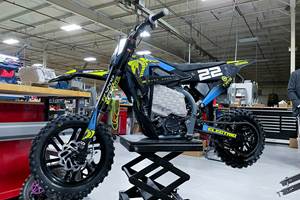Barnes Global Advisors Receives DOD Funding to Develop Resilient Manufacturing Ecosystem
The project funding is tied to critical part needs for the Department of Defense and supports defense industrial base expansion in Western Pennsylvania.
Share
Read Next
The Barnes Global Advisors (TBGA) has been awarded $1.975 million to demonstrate a self-sustaining advanced manufacturing production campus tied to critical part needs for the Department of Defense (DOD).
This award, funded through the DOD’s Industrial Base Analysis and Sustainment (IBAS) Program’s National Imperative for Industrial Skills (NIIS) initiative, will focus on workforce development programs through training and hands-on applications in a production environment. TBGA will leverage its strategic public-private partnership with the Allegheny County Airport Authority to utilize the Neighborhood 91 advanced manufacturing production campus to support these efforts.
Expanding upon TBGA’s industrial experience and involvement in IBAS-funded regional industrial workforce development investments in Texas, Connecticut, Michigan and California, TBGA will leverage proven advanced manufacturing technologies and solutions to drive secure technology and knowledge transition into an existing U.S. advanced manufacturing production campus. The group will also demonstrate “Tech-Know” transition through a pilot program to address production for DOD supply chain issues while simultaneously up-skilling the regional workforce to meet current and projected needs. Another task is to create a blueprint for a Resilient Manufacturing Ecosystem (RME) that can be readily duplicated within other regions of the U.S., or exported outside the U.S., to support DOD mission and supply chain requirements abroad.
“We are very excited to be supporting the Department of Defense with this effort,” says Andy Davis, TBGA director of government programs. “This Resilient Manufacturing Ecosystem award kicks off what we anticipate will be a multiyear effort, with Phase 1 focusing on initial planning, capacity expansion and sample part demonstrations at Neighborhood 91. Long term, we are committed to delivering a comprehensive advanced manufacturing solution encompassing the entire additive manufacturing value chain for the DoD.”
According to TBGA, the past few years have demonstrated that the U.S. has an urgent need to develop a secure and resilient manufacturing supply chain, with emphasis on resilient. “The development of the Neighborhood 91 production campus was a step forward in this goal and this new workforce development effort will move us to the next phase of implementation,”says John E. Barnes, TBGA president. “You can’t have advanced technology without the knowledge to design for it and use it”.
This RME project is contracted through Texas A&M’s Engineering Experiment Station (TEES) Secure America Institute. Key partners include Catalyst Connection and the Neighborhood 91 industrial base, including Wabtec, Cumberland Additive, Metal Powder Works and HAMR Industries.
The Barnes Global Advisors is a large, independent advanced manufacturing engineering consultancy, headquartered in Pittsburgh, Pennsylvania.
- Watch this video with the AM team discussing how Neighborhood 91 is on its way to becoming an end-to-end ecosystem for production additive manufacturing, with details on the campus’ origins and implications of the initiative.
- Read this first article in a series from TBGA, discussing the nature of production additive manufacturing, in which producing good parts isn’t enough. Understanding the full fabrication process is the first step toward controlling it and ensuring ongoing consistency in the end-use parts.
- Here’s the second article in a series from TBGA focused on additive manufacturing. In proving out a new AM material or process, a supplier accumulates data valuable for internal development and customers’ needs. At what point is there enough data for customers to make confident decisions?
Related Content
New Electric Dirt Bike Is Designed for Molding, but Produced Through 3D Printing (Includes Video)
Cobra Moto’s new all-electric youth motocross bike could not wait for mold tooling. Parts have been designed so they can be molded eventually, but to get the bike to market, the production method now is additive manufacturing.
Read MoreHow to Build 10,000+ Shot Molds in Hours
Rapid tooling isn’t so rapid when it takes days to 3D print a metal mold, and then you still must machine it to reach the necessary tolerances. With Nexa3D’s polymer process you can print a mold in hours that is prototype or production ready and can last for more than 10,000 shots.
Read MoreWhat Does Additive Manufacturing Readiness Look Like?
The promise of distributed manufacturing is alluring, but to get there AM first needs to master scale production. GKN Additive’s Michigan facility illustrates what the journey might look like.
Read More3D Printing with Plastic Pellets – What You Need to Know
A few 3D printers today are capable of working directly with resin pellets for feedstock. That brings extreme flexibility in material options, but also requires greater knowledge of how to best process any given resin. Here’s how FGF machine maker JuggerBot 3D addresses both the printing technology and the process know-how.
Read MoreRead Next
3D Printing Brings Sustainability, Accessibility to Glass Manufacturing
Australian startup Maple Glass Printing has developed a process for extruding glass into artwork, lab implements and architectural elements. Along the way, the company has also found more efficient ways of recycling this material.
Read MoreAt General Atomics, Do Unmanned Aerial Systems Reveal the Future of Aircraft Manufacturing?
The maker of the Predator and SkyGuardian remote aircraft can implement additive manufacturing more rapidly and widely than the makers of other types of planes. The role of 3D printing in current and future UAS components hints at how far AM can go to save cost and time in aircraft production and design.
Read More4 Ways the Education and Training Challenge Is Different for Additive Manufacturing
The advance of additive manufacturing means we need more professionals educated in AM technology.
Read More










.png;maxWidth=300;quality=90)













